February 9 - 15, 2014: Issue 149
The High Cost of Dredging The Future - Marine Nation 2025
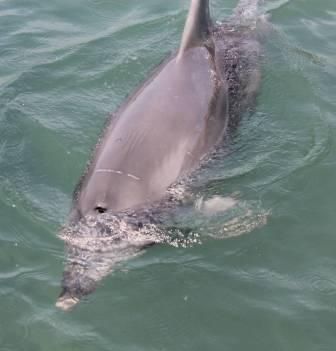 A dredging proposal, as
requested by some user groups of Narrabeen Lagoon of Warringah Council, closes
for public comment on Monday February 10th. Three Options are
Proposed at a cost of 1.32 million ranging up to 2.42 million.
A dredging proposal, as
requested by some user groups of Narrabeen Lagoon of Warringah Council, closes
for public comment on Monday February 10th. Three Options are
Proposed at a cost of 1.32 million ranging up to 2.42 million.
The recommended option will be reported to Council in March 2014. Warringah Council's FAQ's on this states:
If Council decides to proceed with the project, the next stage will involve a feasibility assessment of environmental impacts and net costs/benefits (Stage 2).
If these issues can be resolved, and Council decides to continue to the dredging stage of the project (Stage 3), Council will need to budget for the project from its rate income and obtain the relevant permits and consents. To assist with costs of the project, it is anticipated Council will apply for funds if suitable grant funding opportunities arise.
Last Sunday (2.2.2014) the Australian and Queensland Governments released their 2014 State Party Report on the Great Barrier Reef World Heritage Area , two days after the Great Barrier Reef Marine Park Authority approved an application by North Queensland Bulk Ports Corporation to dump dredge spoil within the Great Barrier Reef World Heritage areas. While Federal Environment minister Greg Hunt states the new report showed Australia had made substantial progress and commitment in responding to the requests of the World Heritage Committee, campaigners for the reef, and even those who operate tourism businesses, state it does not - in fact the opposite will surely occur.
Australia's new government's environmental policies are being portrayed in many overseas media outlets this week as environmental vandalism, with a clear inference on the truer meaning of 'worth' and genuine custodianship intimated. Many within Australia are pointing out the 2014 State Party Report does not address the deteriorating quality of the Barrier Reef, while Queenslanders who live by the Barrier Reef state the GBRMPA has not followed its charter and that those in charge who have approved the dumping of dredge spoil should promptly step down. Opponents propose the approval by GBRMPA and 2014 State Party Report indicate a 'dollars and no sense' scenario that may shortly become a case of 'you can't see the coral for the sludge'.
A letter dated January 29th, 2013, to the GBMRA head, Prof. Reichelt, and signed by 233 of our most authoritative scientists in this area is prefaced by Dr Selina Ward of the University of Queensland stating, “Permission for dumping 5 million tonnes of dredged sediment in the Reef’s marine park would have a detrimental impact on the Reef and make the situation worse. The dumping of dredge spoils in the Reef’s waters off Abbot Point is in opposition to the Authority’s charter to protect the marine park and against the recommendations of UNESCO.”
The undersigned concerned scientists call upon the Great Barrier Reef Marine Park Authority to deny approval of the permit for dumping dredge material in the sea from the Abbot Point Port Development. This would be in opposition to the Charter of the Great Barrier Reef Marine Park Authority.
In the words of the GBRMPA:
The agency’s primary role is best conceptualised through the outcome we aim to achieve:
The long-term protection, ecologically sustainable use, understanding and enjoyment of the Great Barrier Reef for all Australians and the international community, through the care and development of the Marine Park. The first three points of GBRMPA’s approach are the following:
•Protect the values of the Great Barrier Reef Marine Park and Great Barrier Reef World Heritage Area using an ecosystem-based management approach and manage activities so that they are ecologically sustainable.
•Promote ecologically sustainable use of the Marine Park and the coast and catchments adjacent to the Great Barrier Reef.
• Use the best available science, knowledge and information to support environmental policy, regulation and conservation outcomes
Queensland Resource Council chief Michael Roche stated on Sunday, February 2nd: "Flying in the face of the hysterical reaction from some quarters to the granting on Friday of a dredging permit at Abbot Point, the State Party report identifies impacts from port development and dredging as minor, temporary and localised,"
3-5 Million cubic metres of sludge will not be too minor, however you count, could not be termed temporary if the building of a port at Abbot Point, and then at Gladstone, continues expanding, and localised doesn't really take into account that oceans have tides, currents and seasons.
The 2014 State Party Report will be considered by the World Heritage Committee at its 38th session in Doha, Qatar from 15-25 June 2014 but already the indications are that our, and the world's, Great Barrier Reef will placed on the 'in danger' listings. Any further 'announcements' from them probably won't be released on a Friday or Sunday either...
With an estimated 1.6 million visitors to the reef each year, generating $6.4 billion a year to Australia and 240 million to Queensland, employing more than 60,000 people, even if the obligation to ensure future generations get to see what you have seen is ignored, generating a feasible and workable model to keep people employed in the mining industry begs looking west, to drought degraded farmer's lands that may well once have benefited from seaweed in their pastures, instead of keeping your eyes firmly on the ready to hand eastern horizon and the lazy, and degrading of the reef way out. Thousands of years of knowledge advises we enrich our earth and its environments. To ignore this, and not look in all directions, seems a little unwise and part of living in a 'at your own peril' basket... or Galilee basin.
Our children and grandchildren may well be asking, 'who do we sue??' and 'what treatment plants?'... or even , 'what plants did they treat?' since it is they and their peers worldwide who will be burdened with our costs.
Dredging is due to take place, at this stage, between March and June in 2015.
All Media Releases are listed below for the above statements where not linked directly to documents.
______________________________
From this document:
The Oceans Policy Science Advisory Group (OPSAG) is an Australian Government advisory body. Its role includes promoting co-ordination and information sharing between Australian Government marine science agencies and across the broader Australian marine science community. OPSAG is made up of representatives of Australian Government agencies and additional members who assist the group to access stakeholder, industry, and research views and state/territory government considerations.
These are listed in the Marine Nation 2025 document as: Australian Antarctic Division, Australian Bureau of Agricultural and Resource Economics and Sciences, Australian Fisheries Management Authority, Australian Fisheries Management Forum, Australian Institute of Marine Science, Australian Marine Safety Authority, Australian Marine Sciences Association, Bureau of Meteorology, CSIRO, Defence Science & Technology Organisation, Department of Industry, Innovation, Science, Research and Tertiary Education, Department of Sustainability, Environment, Water, Population and Communities, Fisheries Research & Development Corporation, Geoscience Australia, Great Barrier Reef Marine Park Authority, Institute for Marine and Antarctic Studies, Integrated Marine Observing System, Perth Regional Programme Office in support of UNESCO Intergovernmental Oceanographic Commission, PISC RD&E Strategy for Fishing & Aquaculture, Research Providers Network, Royal Australian Navy – Australian Hydrographic Service, Royal Australian Navy - Hydrography, Meteorology and Oceanography Branch, States and Territories Governments, Sydney Institute of Marine Science and the UWA Oceans Institute.
Australia’s marine science capability is broadly-based, but it is unrealistic to expect that every institution involved in marine research and education will have its own world class laboratory and experimental facilities. This has led the Australian Government, and a number of state governments, to make investments that bring multiple institutions together to create regional hubs with critical mass in areas of natural advantage. For example, through the Super Science Initiative and Education Investment Fund, major hubs with new laboratory and experimental facilities have been created in Townsville for tropical ocean and coral reef research; Hobart for Southern Ocean and Antarctic research; Perth for Indian Ocean and north-west shelf research; and Sydney for sub-tropical and temperate ocean research. State government investments underpin hubs focused on marine innovation in South Australia and ecosciences in South East Queensland. These investments have created vibrant, creative precincts that support world-class marine science and encourage collaboration among institutions. As identified in the National Research Investment Plan30, commitment to ongoing funding is required to capitalise on existing investment, and ensure continuing development of intellectual critical mass, world-class expertise, and support for the hubs as foci for international collaboration.
Many of the future advances in marine science will flow from advances in allied fields (e.g. material sciences and the suite of ‘omics’ approaches being pioneered in medical and plant sciences). Marine science will increasingly seek access to cross disciplinary experimental and analytical facilities such as Bio-Platforms Australia and the National Synchrotron. To ensure that marine science applications are factored in to future investments in National Collaborative Research Infrastructure, we recommend that the marine science community be actively engaged in consultation on future infrastructure road mapping exercises and prioritisation of investments.
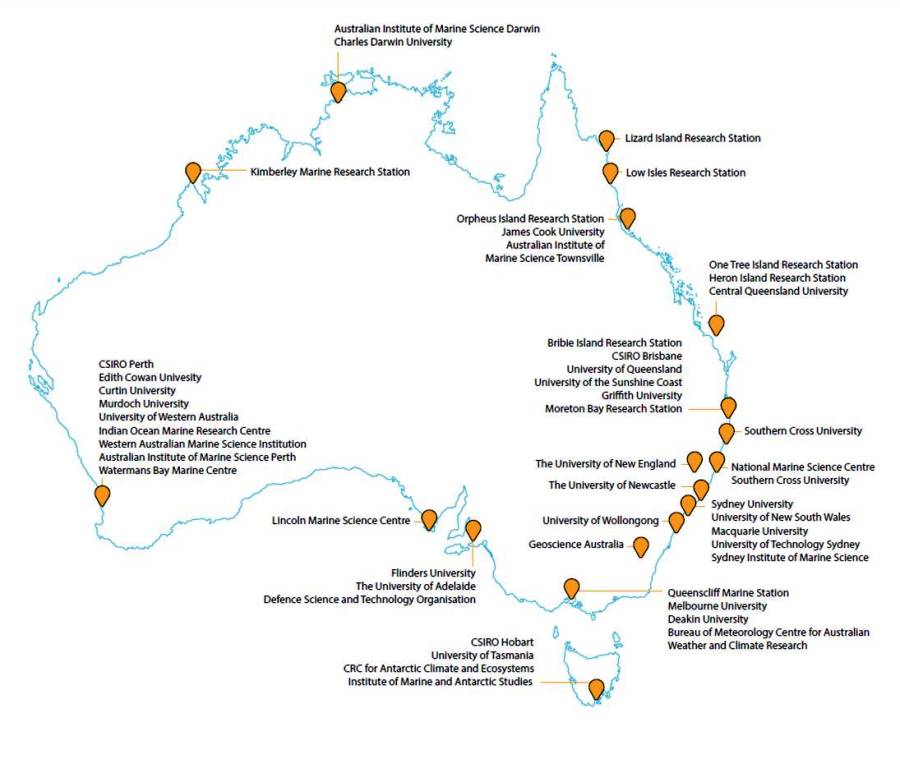
__________________________________________
Getting back to the coral, and the Barrier Reef, the Australian
Institute of Marine Science (AIMS) allows us a positive note on what is achieved
through the large body of people who work in the marine world of Australia and
its associated bodies when looking in all directions is applied;
‘Hidden' and new species of coral identified by AIMS scientists – January 20, 2014
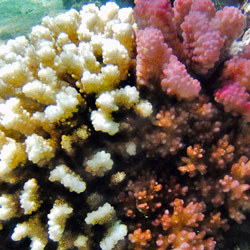 A
coral colony consisting of the new described species Pocillopora bairdi
(left half), P. meandrina (top right) and P. damicornis
(bottom right). Photo: S Schmidt-Roach
A
coral colony consisting of the new described species Pocillopora bairdi
(left half), P. meandrina (top right) and P. damicornis
(bottom right). Photo: S Schmidt-Roach
Scientists have discovered ‘hidden' coral species diversity by applying a combined approach of DNA analysis, skeleton examination and ecological observations. Their research shows how essential it is to employ multiple methodologies, from molecular to traditional techniques, in understanding coral diversity and evolution. Their research is published in the Zoological Journal of the Linnean Society this month.
"We measured the skeletal structure of these species of corals and combined this data with our genetic and molecular analysis. Our results indicate that there are likely to be many more species of coral in our oceans, more than we originally thought," said AIMS researcher, Sebastian Schmidt-Roach.
The team formally revised the taxonomic status of Pocillopora corals, also known as ‘cauliflower corals' found in the Indian and Pacific Oceans. They also reported the discovery of two new species during their studies. Their research included studying corals on the Great Barrier Reef.
"Coral species can be very difficult to identify. They are not obviously different like most species of mammals, for example. Some corals may interbreed with other species of coral (hybridize) and different species can look the same but be very different, genetically and chemically. That is why information from multiple sources is necessary for studying these animals at a population and species levels" explained Nikos Andreakis, a molecular phylogeneticist at AIMS.
The scientists have now provided information for the identification of eight Pocillopora species, two of them were completely new to science: P.damicornis, P.acuta, P.aliciae, P.verrucosa, P.meandrina, P.eydouxi,P.cf. brevicornis and Pocillopora bairdi sp. nov..
The study is part of Sebastian Schmidt-Roach's PhD project at AIMS and the University of Tasmania.
The full journal article can be viewed at: http://onlinelibrary.wiley.com/doi/10.1111/zoj.12092/full
Marine Nation 2025 video: taking a national approach to marine research
This video, Marine Nation 2025, outlines the breadth and value of Australia's ocean territory and the benefits of research initiatives dedicated to its development, management and conservation. By 2025, marine based industries such as fishing, aquaculture, tourism, shipping and ship building, and oil and gas production, will be contributing nearly A$100 billion annually to the Australian economy. Marine science plays a vital role in unlocking, developing, and managing that potential, and is the key to delivering solutions for some of our most pressing challenges facing our society. Given the complexity of these challenges, and the scale of the effort required, Australia needs a coordinated, national approach to marine research. The Oceans Policy Science Advisory Group promotes coordination and information sharing between Australian Government marine science agencies and across the broader Australian marine science community.
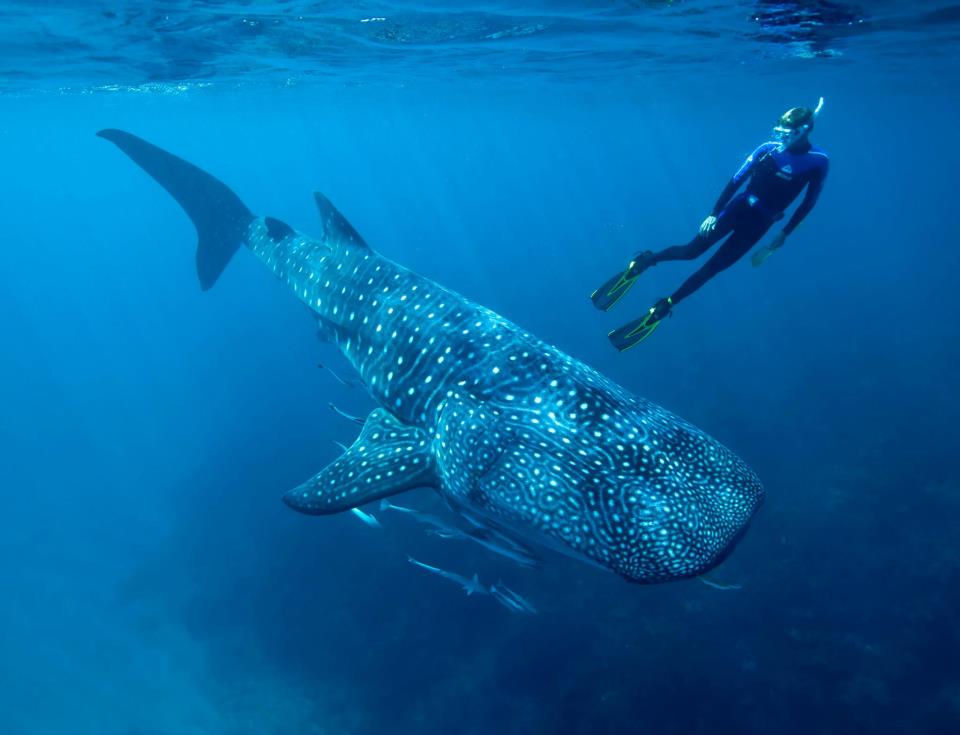
Strict conditions placed on approval for Abbot Point permit - received 2/2/2014- From: GBRMPA Media
After rigorous assessment, the Great Barrier Reef Marine Park Authority has approved an application by North Queensland Bulk Ports Corporation to dispose of dredge spoil at a deepwater location offshore of Abbot Point, subject to strict environmental conditions.
Authority Chairman, Dr Russell Reichelt, said he recognised the amount of debate and community concern that the project had generated and shared with everyone a strong desire to ensure the Reef remains a great natural wonder into the future.
“This approval is in line with the agency’s view that port development along the Great Barrier Reef coastline should be limited to existing ports,” Dr Reichelt said.
“As a deepwater port that has been in operation for nearly 30 years, Abbot Point is better placed than other ports along the Great Barrier Reef coastline to undertake expansion as the capital and maintenance dredging required will be significantly less than what would be required in other areas.
“It’s important to note the seafloor of the approved disposal area consists of sand, silt and clay and does not contain coral reefs or seagrass beds.”
General Manager for Biodiversity, Conservation and Sustainable Use, Bruce Elliot said the stringent environmental conditions imposed on the dredge disposal would help protect biodiversity, heritage and social values of the multi-use Marine Park and ensure potential impacts of this activity are avoided, mitigated or offset.
“The Federal Environment Minister, as part of his approval conditions for this development, has required North Queensland Bulk Ports to identify alternate disposal sites within an identified investigation zone,” Mr Elliot said.
“We would support the use of an alternative site if it is found to be equal to or better in terms of environmental or heritage outcomes.”
Mr Elliot said the agency had fully considered and taken into account the Environment Minister’s approval, granted on 10 December 2013, of the capital dredging program and dredge disposal site for the Abbot Point terminal expansion, as well as community views and relevant scientific and technical reports.
“By granting this permit application* with rigorous safeguards, we believe we are able to provide certainty to both the community and the proponent while seeking to ensure transparent and best practice environmental management of the project,” he said.
Forty-seven environmental conditions, which reflect the latest science and best industry management practices, as well as the conditions already put in place by the
Environment Minister, impose strict mitigation measures such as:
measures to minimise impact on biodiversity, particularly coral
a long-term water quality monitoring plan that extends five years after the disposal activity is completed
a heritage management plan to protect the Catalina World War II aircraft wreck located in Abbot Bay
offset measures for commercial fishers in the event of adverse impacts
a requirement to prevent any harm to environmental, cultural and heritage values of any areas beyond 20 kilometres from the disposal site
environmental site supervision by a GBRMPA nominee
establishment of an independent dredging and disposal technical advice panel and a management response group which will include community representatives.
The approved disposal site is located approximately 25 kilometres east-north-east of the port, while the investigation zone being assessed for alternative locations is located 20 to 30 kilometres from the area being dredged.
All material destined for ocean relocation is tested by accredited laboratories and has to comply with strict requirements under the National Assessment Guidelines for Dredging.
Testing has confirmed there are no identified contaminants in the sediments in Abbot Point that will be dredged and relocated.
* Takes you to permit - is 4.2MB
New report shows significant progress in protecting the Great Barrier Reef - The Hon. Greg Hunt MP; Minister for the Environment, The Hon. Andrew Powell MP; Queensland Minister for Environment and Heritage Protection – joint Media Release 2 February 2014
The Australian and Queensland Governments have today released the 2014 State Party Report on the Great Barrier Reef World Heritage Area which highlights the significant progress being made to improve the management, health and protection of this amazing iconic area.
This progress report has been delivered to the World Heritage Committee meeting currently underway and demonstrates unequivocally the Australian and Queensland Governments’ commitment to better managing and protecting this natural wonder.
Federal Environment Minister Greg Hunt said getting the management and protection of the reef right is a top priority for the Abbott government.
“The Government is implementing important initiatives such as our Reef 2050 Plan, Reef Trust, and funding vital projects such as Crown of Thorns Starfish eradication and the Gladstone Healthy Harbours Partnership”, he said.
“The federal Government is working closely with Queensland to help protect this Australian icon for future generations.
“The report shows that the Great Barrier Reef’s outstanding universal value and integrity remain largely intact and Australia has made substantial progress and commitment in responding to the requests of the World Heritage Committee.
“In close cooperation with the Queensland Government, we are boosting the conservation of the Reef through a range of approaches both on land and in the marine environment.
“This includes carrying out the comprehensive strategic assessment of the Great Barrier Reef, an ongoing commitment to the Reef Water Quality Protection Plan and continuing strict protection under national environment laws.
“It was the Abbott Government that ensured the Abbot Point project was one-twelfth the size of what was proposed under previous state and federal Labor governments.
In addition the Government has also ruled out in advance the previous Labor Government’s 12 million cubic metre dredging proposal for the Great Barrier Reef Marine Park near Gladstone”, Mr Hunt said.
The report also confirms that the management changes and water quality improvements being implemented are having a positive impact on water quality across the Great Barrier Reef catchments through the 2011 Reef Plan Report Card
Queensland Minister for Environment and Heritage Protection Andrew Powell said the Queensland Government was equally confident that it would meet the World Heritage Committee expectations regarding reef management.
“The Queensland government has carried out a significant amount of work to help improve the health of the reef and protect it in the future,” Mr Powell said.
“We have established the Gladstone Healthy Harbour Partnership and released our draft ports strategy and the strategic coastal zone assessment for public consultation.
“We are also working with farmers to reduce run off onto the reef through our Best Management Practice (BMP) programs and we are seeing improvements to water quality in our Reef report cards.”
Among the Australian and Queensland governments’ other key achievements since the 2013 State Party Report are:
Releasing a Scientific Consensus Statement on land use impacts on water quality and ecosystem condition which confirms that the greatest cause of decline in Great Barrier Reef water quality has been associated with terrestrial run-off from broad scale agriculture.
Releasing a draft Queensland Ports Strategy that commits to concentrating port development within existing major port areas to improve their efficiency and environmental management.
Completing an Independent Review of the Port of Gladstone that proposes principles for improved port operation, including the incorporation of World Heritage protection and cumulative impact assessment in planning (these findings have also informed the development of the Queensland Ports Strategy).
Releasing a draft North-East Shipping Management Plan that proposes measures to help manage any risks of increased shipping traffic, including some measures to be implemented through an Anchorage Management Working Group.
The government has also committed $140 million through our reef programme over the next five years to improve the quality of water flowing into the Great Barrier Reef lagoon and enhance the reef’s resilience.
Minister Hunt said Australians can be proud of our achievements to date in protecting the Great Barrier Reef World Heritage Area.
“We are confident that we have the appropriate processes, resources and environmental protection mechanisms in place to ensure that the Great Barrier Reef continues to be among the best managed and protected World Heritage areas in the world.”
_______________________________________
Supporting recreational fishing while protecting our marine parks - Joint Media release, 14 December 2013 - The Hon. Greg Hunt MP, Minister for the Environment and Senator the Hon. Richard Colbeck, Parliamentary Secretary to the Minister for Agriculture
The Coalition Government is delivering a key election promise by scrapping Labor's plan to lock out recreational fishers from key coastal areas around the country. We are protecting the marine reserves but rejecting the flawed plans. The Government has acted to prevent Labor's flawed marine management plans from locking out fishers. All Commonwealth marine reserves and parks will remain, as will their boundaries but the management plans will be redeveloped.
The Governor-General has reproclaimed the new Commonwealth marine reserves. This invalidates the management plans signed off by Labor and stops the exclusion zones that would have come into effect next July, while keeping the parks and their boundaries - exactly as we committed.
The Government will create new management plans to protect the marine environment, based on science and in consultation with stakeholders and local communities.
The Government does not support locking out large areas of oceans to prevent fishers from taking out a boat and casting a line.
"Labor's proposed changes would have meant it would be against the law for recreational fishers to cast a line at some of their favourite fishing spots across the country," said Minister Hunt.
"The Coalition is adopting a balanced approach that will protect the marine environment while still ensuring a sustainable seafood resource and access for recreational anglers," said Senator Colbeck.
"Labor's plan was going to hurt tourism and commercial fishing operations."
"The Government remains committed to marine parks and the external boundaries of the new marine reserves remain unchanged," said Minister Hunt.
"I have asked my department to begin work on a Marine Reserves Review to consider what management arrangements will best protect marine ecosystems and accommodate the many industries and recreational fishers that use our oceans."
The review has two components:
the appointment of an expert scientific panel to look closely at the science supporting the current marine reserves
the establishment of Bioregional Advisory Panels to facilitate and improve consultation with stakeholders
The make-up of the panels and their terms of reference will be announced in early 2014.
Until the new management plans come into effect, there will be no "on the water" changes. The 25 reserves that predated last year's extension of the Commonwealth marine reserve network will continue to operate under their current arrangements.
_________________________________________
State Party Report on the state of conservation of the Great Barrier Reef World Heritage Area (Australia) - 2014
Purpose of this report
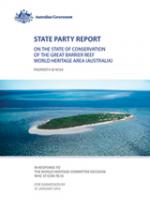 This 2014 State Party Report is a progress report outlining Australia’s
substantial progress in implementing key requests made by the World Heritage
Committee (Decisions 35 COM 7B.10 , 36 COM 7B.8 and 37 COM 7B.10) and
recommendations of the Mission Report, Reactive Monitoring Mission to the Great
Barrier Reef (Australia) 6th to 14th March 2012).
This 2014 State Party Report is a progress report outlining Australia’s
substantial progress in implementing key requests made by the World Heritage
Committee (Decisions 35 COM 7B.10 , 36 COM 7B.8 and 37 COM 7B.10) and
recommendations of the Mission Report, Reactive Monitoring Mission to the Great
Barrier Reef (Australia) 6th to 14th March 2012).
This 2014 report builds on the extensive information already provided in the 2012 and 2013 State Party reports. Australia will continue to keep the World Heritage Committee informed of progress and will provide a further State Party Report by 1 February 2015.
Structure of this report
The executive summary includes a report card demonstrating Australia’s progress against the 2013 World Heritage Committee decision. Appendix 2 provides an overview of progress against all the monitoring mission recommendations and the 2011 and 2012 committee decisions concerning the state of conservation of the GBRWHA.
Chapter 1 is the introduction to the report.
Chapter 2 identifies current conservation issues, including key findings of the draft strategic assessments on the condition and trend of the Outstanding Universal Value and integrity of the GBRWHA.
Chapter 3 summarises Australia’s progress in responding to the 2013 World Heritage Committee decision (37 COM 7B.10), making reference also to recommendations in the 2012 World Heritage Committee decision and reactive monitoring mission report. Chapter 3 also outlines corrective actions being developed by the Australian and Queensland governments.
Chapter 4 provides an overview of legislative protection and a summary of proposed, withdrawn and approved developments within and outside the GBRWHA.
Available to download in full HERE